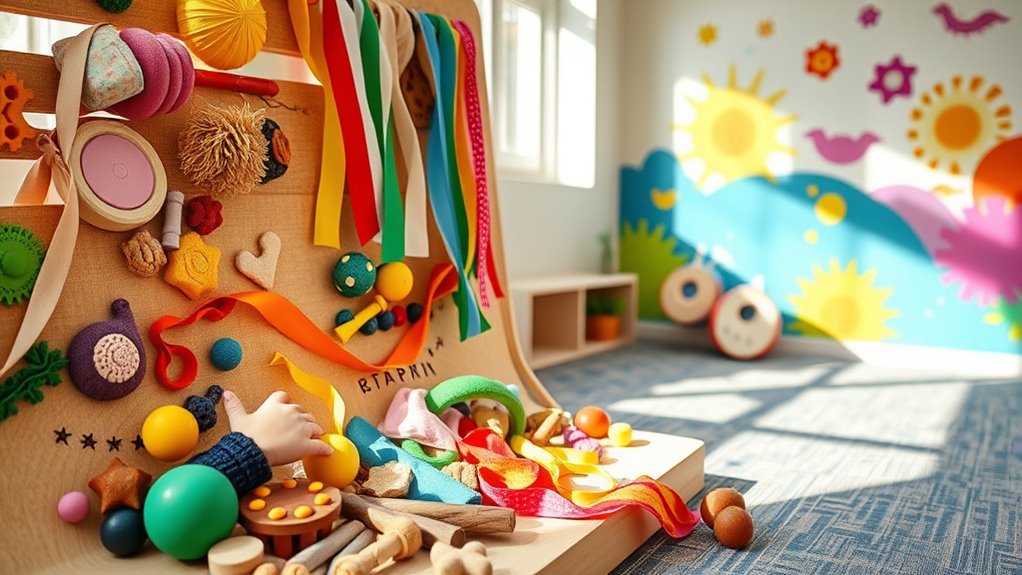Engaging children in sensory play involving touch, sound, and sight helps boost their language development. When you use activities like exploring textures, singing songs, or showing colorful objects, you stimulate their vocabulary and speech patterns naturally. These experiences encourage imitation, recognition, and descriptive skills, making learning fun and effective. By consistently incorporating multisensory activities, you create a rich environment that fosters ongoing language growth. Keep exploring to discover how to maximize these engaging methods for your child’s progress.
Key Takeaways
- Sensory play enhances vocabulary and communication skills through tactile, auditory, and visual experiences.
- Incorporating music therapy with sensory activities boosts sound recognition and speech confidence.
- Tactile exploration links textures to descriptive words, enriching language and conceptual understanding.
- Combining sight, sound, and touch creates engaging environments that promote natural language development.
- Regular, playful sensory activities reinforce learning, attention, and neural connections essential for language growth.

Sensory play offers a powerful way to support language development in young children. When you engage your child in activities that stimulate their senses, you’re laying a strong foundation for vocabulary growth and communication skills. One effective method is through music therapy, which combines auditory stimulation with emotional and social benefits. Singing songs, clapping rhythms, or playing simple instruments lets your child experience different sounds, pitches, and rhythms. These activities not only entertain but also encourage them to imitate sounds, recognize patterns, and expand their language skills. Music naturally fosters interaction, prompting your child to respond verbally or through gestures, reinforcing their understanding of words and concepts.
Tactile exploration is equally essential in sensory play, especially when it comes to language development. By encouraging your child to touch and feel various textures—such as soft fabrics, rough sandpaper, smooth stones, or squishy playdough—you help them connect words to their sensory experiences. As they describe what they feel, they practice using new vocabulary and form mental images associated with those textures. For example, you might say, “This feels soft,” or “That’s rough,” prompting them to repeat or expand on these phrases. This active engagement makes language more meaningful and memorable. As your child explores different tactile materials, they also learn to categorize and compare, which enhances their descriptive skills and understanding of language structure.
Incorporating both music therapy and tactile exploration into your child’s routine creates a rich, multisensory environment that stimulates their developing brain. When you sing songs with repetitive phrases or rhymes, your child begins to recognize familiar words and sounds, building their confidence in speech. Simultaneously, presenting a variety of textures encourages them to describe and differentiate their sensory experiences, expanding their vocabulary naturally. These activities also promote attention and focus, as your child learns to listen closely to sounds and observe tactile details. By making these experiences interactive and enjoyable, you foster an environment where language learning happens effortlessly and joyfully. Remember, consistency is key—regularly integrating music therapy and tactile exploration into playtime will steadily support your child’s language growth and overall development.
Frequently Asked Questions
How Can Sensory Play Boost Early Vocabulary Skills?
Sensory play boosts your child’s early vocabulary by encouraging tactile exploration and auditory stimulation. When they feel different textures, they learn new words like rough, smooth, or bumpy. Sounds from toys or singing help them associate words with actions or objects. By engaging their senses actively, you help your child connect words to experiences, making language learning more meaningful and memorable. This hands-on approach sparks curiosity and supports vocabulary growth naturally.
Are There Any Safety Concerns During Sensory Activities?
Oh, safety during sensory play? Who knew that fun could come with hazards? You’ll want to childproof hazards like choking risks and sharp objects, and consider allergy considerations—some materials might cause reactions. Always supervise closely, guarantee everything is non-toxic, and keep an eye for potential choking or ingestion. It’s all about balancing exploration with safety, so your little one can enjoy the sensory experience without unexpected surprises.
What Age Is Most Appropriate for Sensory Play?
You should introduce sensory play when your child is within the age range of birth to around three years old, as this aligns with key developmental milestones. During this period, their senses rapidly develop, making sensory activities highly beneficial. At this stage, your child explores the world through touch, sound, and sight, helping to boost their cognitive and language skills. Always guarantee activities are age-appropriate and safe for their developmental level.
How Do I Customize Sensory Activities for Different Learning Styles?
Think of customizing sensory activities like tuning a musical instrument—you adjust the notes to suit each child’s unique rhythm. Use multisensory approaches and individualized strategies to cater to different learning styles, whether a child thrives on tactile, auditory, or visual input. Observe their responses carefully, then tweak activities to keep them engaged and excited, turning learning into an adventure tailored just for them.
Can Sensory Play Assist Children With Developmental Delays?
You can definitely use sensory play to help children with developmental delays by focusing on tactile exploration and sensory integration. Engaging their senses allows them to process information more effectively, improving coordination and communication skills. By providing activities that stimulate touch, sound, and sight, you support their brain development and help them build essential skills at their own pace. Sensory play becomes a valuable tool for fostering growth and confidence.
Conclusion
By engaging in sensory play, you open a doorway to vibrant worlds where touch, sound, and sight become the brushstrokes of language development. Just as a gardener tends to each plant, nurturing their growth, your active participation helps your child blossom into confident communicators. Embrace these playful moments, and watch as words and expressions bloom like flowers in a sunlit garden—your child’s language skills thriving with every sensory adventure.











